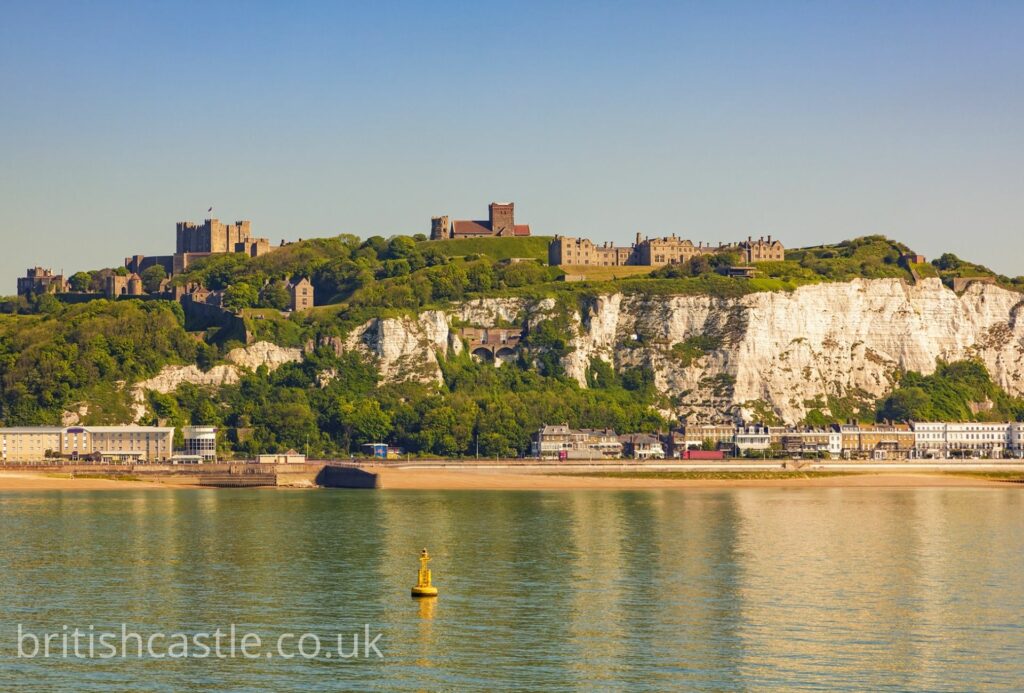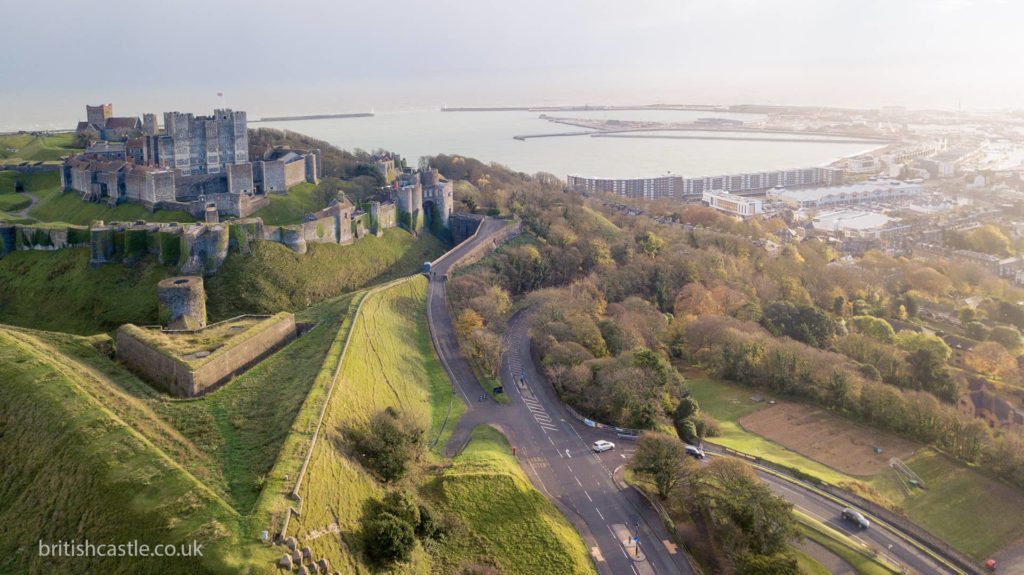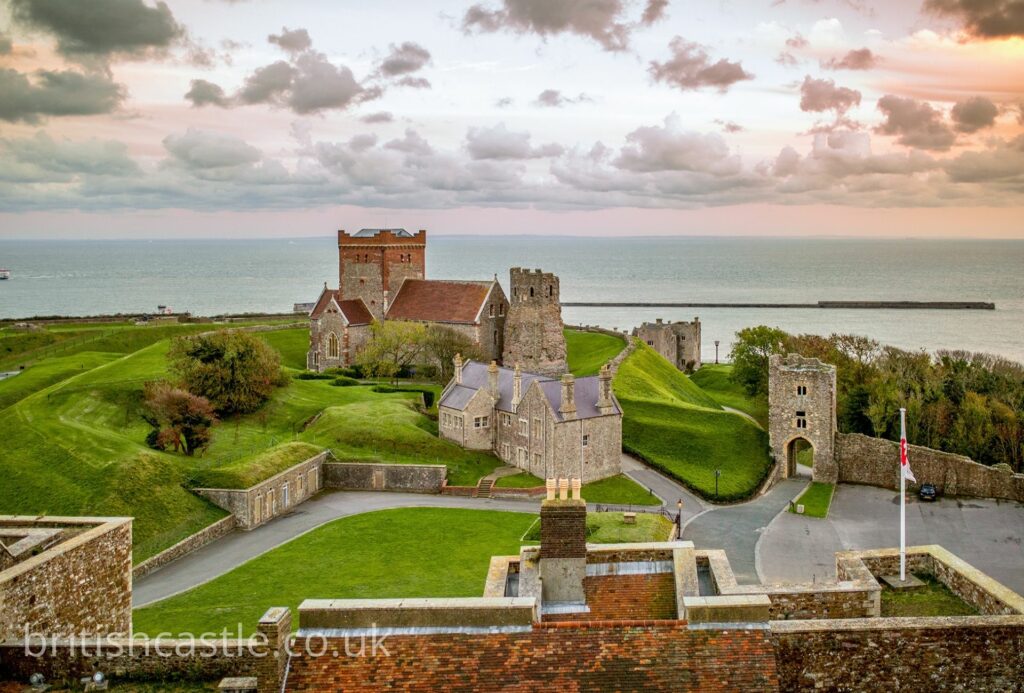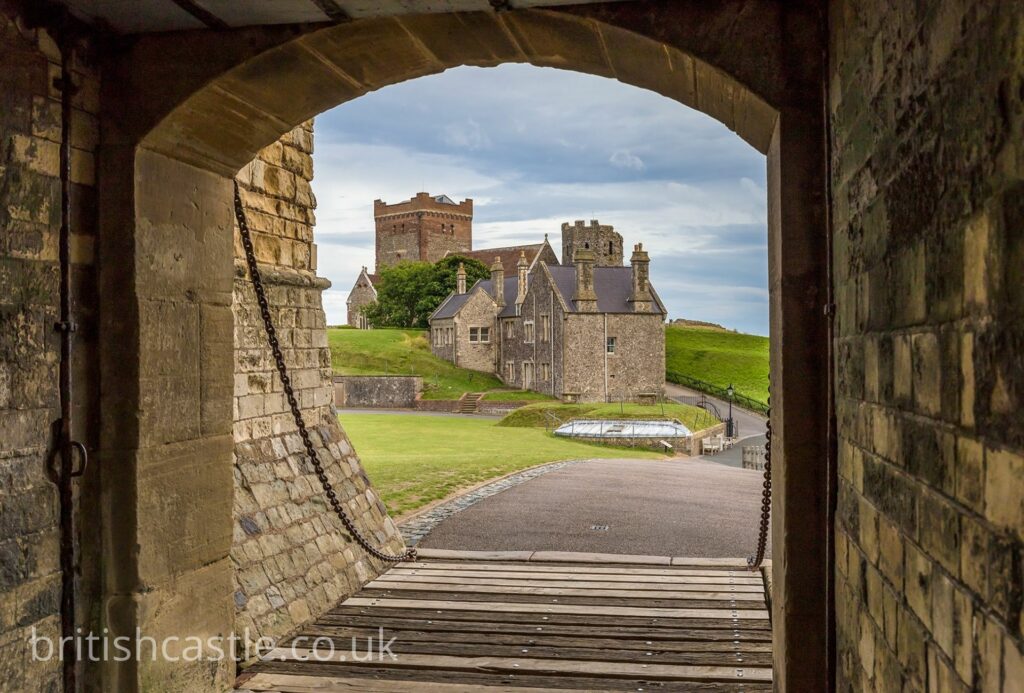Dover Castle, one of a number of castles in Kent overlooks the strategic port town of the same name.
Founded in the 11th century, Dover Castle is more than just a building. Located in Dover, Kent at one of the southernmost points in England, its position overlooking the Strait of Dover, the shortest sea crossing distance between England and continental Europe, has made it one of the most valuable defensive fortresses in the country’s history.
A veritable gateway to the United Kingdom, Dover Castle has sat gallantly for centuries, playing host to royalty, warmongers and vagabonds, while experiencing numerous architectural face-lifts.

Stunning, strategic, and rich in over 2000 years of history, the fortification overlooking the Straits of Dover, the shortest crossing between England and the continent of Europe, is a mixture of design elements from the Iron Age all the way to World War II.
Visitors to the site can view prehistoric earthworks, a Roman lighthouse, a Saxon church, a rectangular Norman keep, medieval concentric defences, Henry VIII’s Moat Bulwark, and secret tunnels constructed during World War II. Dover Castle has weathered many storms, serving as Guardian of England from its perch above the White Cliffs.

The History of Dover Castle
Dover Castle in the Roman Era
While historians have gone to extensive lengths to date the original structure, Dover Castle, which has sat on Castle Hill in its current place for centuries, the findings are often mixed. But the general conception is that it likely dates to the pre-Roman Iron Age based on the earthworks at the site––which feature many unusual shapes and designs that are not often associated with medieval architecture.
The greatest example of this type of Roman style is reflected in the existing lighthouse on site, which remains the tallest standing Roman structure in all of England. Dating back to around 130 A.D., it is a tiered tower (or pharos) in a traditional octagonal shape and its survival, like much of Dover Castle, is based on fortifications and advancements made throughout the centuries. A second, similar lighthouse was built on the opposite western hill, and both were used to navigate ships through the narrow river mouth. These duelling structures were part of a strategic defensive measure at the fort at Castle Hill.
This fort would be demolished around 215 A.D. only to have a new one erected about 50 years later on the same site, with the two surviving lighthouses in operation for at least another 700 years. It was around this time (roughly 1000 A.D.), that the Church of St. Mary in Castro was constructed in the Saxon style, incorporating one of the remaining Roman lighthouses––both of which remain on Dover Castle grounds today.
The Medieval Castle at Dover
Around the time of his success after the Battle of Hastings in 1066, William the Conqueror captured the port at Dover and established a solid fortification near the church. The structure at Dover was eventually extended in the early 12th century, though little is known about the style or design of this building. This would all change with the next inhabitant.
The main house at Dover Castle, as it exists today, was formally established by King Henry II in around 1180. An elaborate spendthrift, Henry spared no expense in crafting an ornate and lavish château, while his official foreman, Maurice the Engineer, built a great keep, as well as the inner and outer baileys and the Great Tower––an advanced structure that combined residential elegance with defence measures, giving the current site its stately presence.

Henry was determined to create the most advanced layout design in Europe; not only as a dedicated residence fit for a king but also, given the lack of substantial properties in Kent at the time, he needed an impressive domicile in which to host dignitaries and important visitors travelling through the pilgrimage route to Canterbury. All in all, by the time of Dover Castle’s completion in 1188, Henry had spent an estimated £7,000––a sizeable number at the time.
Dover Castle Throughout the Years
The placement of Dover Castle near the southern tip of England, overlooking the Strait into France, would play a crucial role in its history throughout military conflict, one of the earliest of which occurred following King John’s loss of the Duchy of Normandy to the French King Philip II in 1204. As a result, tensions brewed between both factions as enemy territory now resided just across the Channel.
By 1216, the First Barons’ War resulted in the first significant siege of the new stronghold when John’s army fought rebels who were intent on claiming the English crown for France. The walls at Dover Castle were breached but the other defensive measures prevented a successful occupation.
When the war ended the following year, renovations fell to King Henry III, who fortified the north gate, converting it into an underground forward-defence complex (comprised of St John’s Tower). Builders remade the barbican and stronger gates were incorporated into the outer curtain wall on the western (Fitzwilliam’s Gate) and eastern (Constable’s Gate) sides, while greater stock was placed in attacking France from a more unexpected route: underground. This is where we first see developments into the complex network of tunnels of which Dover Castle is famous.
By now, Dover Castle was one of the most sophisticated and impressive (and royal-occupied) castles in all of Europe.
Dover Castle in the Tudor-Stuart Era
Little is known about the inhabitants at Dover Castle throughout the Middle Ages until the reign of King Edward IV in 1461 when significant renovation work was executed at the Great Tower. This move was likely made to accommodate the Duke of Burgundy, a strong ally, who ruled the nearby location route to Flanders.
Under King Henry VIII, military measures were ramped up at Dover Castle with the installation of artillery forts in 1539. In addition to further restructuring, Henry also famously hosted the Holy Roman Emperor as part of a historically diplomatic visit. Anne of Cleves was also factored into the renovations, particularly the refurbishment of the Great Tower’s residential apartments where she lived in preparation for her marriage to the king in 1539.
Dover Castle was last used by royalty in 1625 when Princess Henrietta Maria of France was hosted on site before her marriage to England’s Charles I. Following this period of calm, the Duke of Buckingham, a favourite of the king, made continued alterations to the Great Tower and a section of buildings within the inner bailey. It is unclear why Dover Castle was all but abandoned by the Crown but despite this, it would remain a pivotal military observation point for the cross-channel sightings of the Anglo-French Survey.

By the 17th century, Dover Castle had become severely neglected. So much so, that it saw minimal occupation or artillery fire during the Civil Wars that took place between 1642 – 1645. Half a century later, around the time of the Nine Years War (1688 – 1697), the Great Tower was used as a prison for French and Spanish prisoners––and some of their graffiti can still be seen on the walls.
In order to enter the four-storey keep, one passes through a large building with an impressive staircase and two chapels – the Norman upper chapel, and the Gothic style lower chapel. This building, which wraps around the south-eastern corner of the keep, forms a partial inner defence around which are two concentric walls. Most of the other buildings which were part of the inner bailey are no longer intact, having been replaced by later construction, but the ruins of some can still be seen.
Embedded in the inner wall were ten rectangular towers, as well as gatehouses to the north (King’s Gate) and south (Palace Gate), each with two large towers. The entrances to Dover Castle were further defended by barbicans. Henry II also began the construction of the outer curtain wall. In this concentric design, Henry and Maurice anticipated other concentric castles in Britain by about 100 years.
The outer curtain wall was completed by King John in the early 13th century. A total of twenty individual towers of various shapes (round, square, and D-shaped) allowed defence of the long outer wall. Later, the King’s Gate, which had been largely destroyed during King John’s conflict with the barons, was replaced by Norfolk Towers.
A new gate was constructed to contain quarters for the constable of Dover Castle. The Constable’s Gate was composed of several round towers of different sizes, two of which join over the entranceway to provide access for defenders.
Dover Castle in the Modern Era
The greatest modifications to Dover Castle since Henry II occurred during the Napoleonic Wars around the final years of the 18th century. Following his brief to improve the town’s defences, William Twiss, the Commanding Engineer of the Southern District, executed reconstruction of many of the stronghold’s outer elements, including the barbican which was remodelled as an infantry strong point, while the north-east outer wall was shortened and reinforced by earthwork to help absorb incoming cannon fire––which ultimately led to the building of Four Gun Battery and Bell Battery points and bastions for gun positions on the eastern side. Twiss also constructed Canon’s Gateway to link the defences of the castle with those within the town.
By early 1800, Dover had become a garrison town and, as such, there was a heavy need for accommodating troops. Twiss devised a channel of underground barrack tunnels about 15 meters below clifftop which were used to house the infantrymen and their storage.
To keep up with 19th-century military advancements, further improvements were made to the inner bailey and Great Tower in 1853, followed by the addition of more barracks and buildings for soldiers. In 1865, the construction of Fort Burgoyne, a fortress to the north of Dover Castle, helped strengthen the overall complex of cliff-side strongholds, allowing for greater coastal visibility to any potential incoming enemy ships. The improvements also proved invaluable for two upcoming periods of infighting––World War I and World War II.
Following the first declaration of war in 1914, Dover Harbour became home to the Royal Navy’s Dover Patrol. Dover Castle became headquarters to a garrison of about 15,000 troops, many of whom trained in camps within the perimeter. Anti-aircraft guns were positioned near St. Mary in Castro to defend from the new threat of German airships. Luckily, however, Dover Castle saw minimal damage.
By the time war broke out again in 1939, the stronghold had resumed its former role. The underground casemates were re-commissioned as bomb-proof offices for the vice-admiral in charge of the naval base––who would eventually prove instrumental in aiding with the evacuation of troops at Dunkirk. Escaping much enemy fire for the second period of battle in less than 30 years, Dover Castle had ultimately, and successfully, served its purpose.
The Army mostly abandoned Dover Castle in 1958, and the underground tunnels were decommissioned in the 1980s, at which point the aged building assumed a new life as a tourist spot and eventual set for filming.
Dover Castle tunnels
One of the most intriguing aspects of Dover Castle is the network of tunnels which were dug into the White Cliffs during the Napoleonic War and expanded during World War II. The tunnels played a critical role in British history as the centre of operations during the evacuation of British soldiers from Dunkirk in May 1940. There was even a hospital inside the tunnels to meet the medical needs of the soldiers, many of whom had been wounded as they were forced off the Continent by German troops.
Visiting Dover Castle
Historical recreations are performed by costumed performers each weekend (between April and September), providing in-depth perspective to Dover Castle’s significance as a fortress throughout centuries of countless wars. For those who prefer to discover on their own, there are over eighty acres of grounds to explore––many of which offer uninterrupted views of the majestic sea from a truly unique vantage point.
Tickets provide visitors with guided or solo trips around the fortress’s battlements and defences, plus exploration of the subterranean medieval tunnels. There’s even a challenging, interactive Bunker Escape Room for groups.
The Great Tower Café, built in 1901, also provides visitors with hot lunches, tea and sweets, while the NAAFI Restaurant offers larger options plus exceptional views of the port of Dover.
For more information on experiencing Dover Castle in person, visit their website.
Dover Castle is owned by English Heritage and is open to the public on most days (Coronavirus restrictions notwithstanding). Guided tours of the tunnels are available but the number of visitors is limited, so be sure to arrive early. For more information, please visit the Dover Castle page from English Heritage